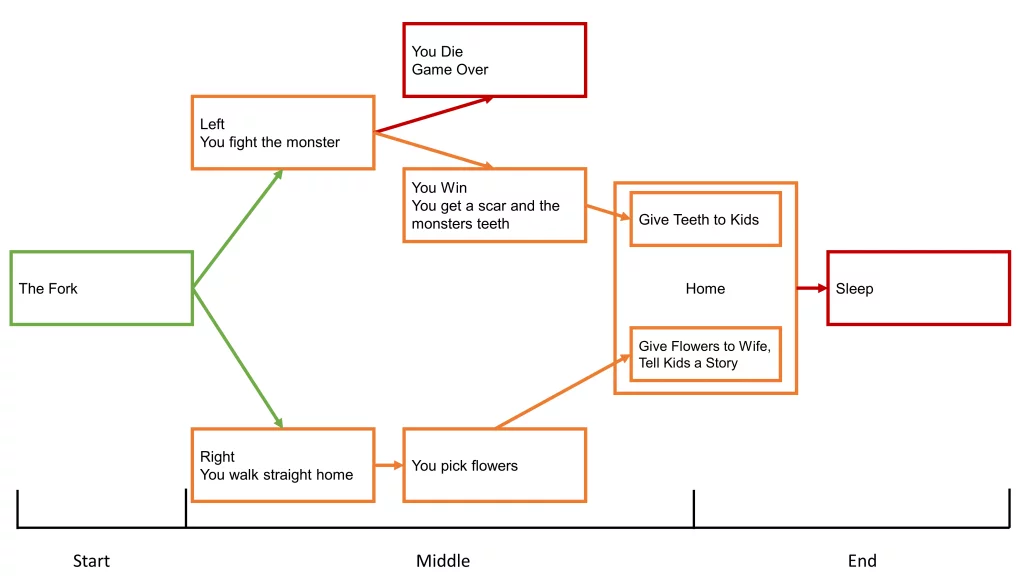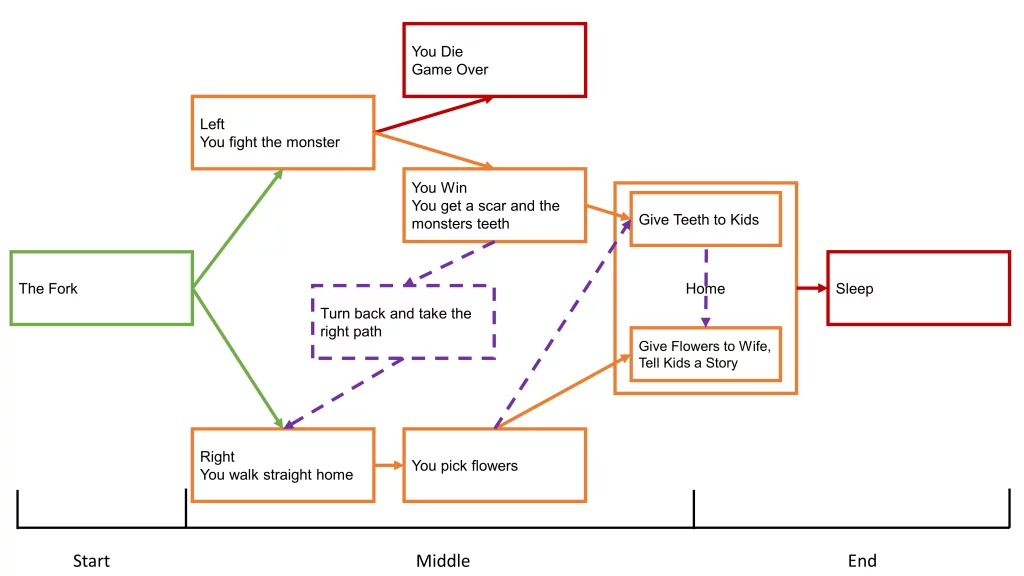
Narrative atoms are small units of narrative or story that can, within the context of the overall narrative, stand alone. That does not mean they need to be completely self-explanatory, just sit comfortably on their own.
In a standard linear story, each atom would be placed sequentially, so their ability to stand alone is less important. However, in many games narrative bends and twists and turns in a non-linear way. For that to work, for a story to makes sense as it jumps from A to C to G to B and back again, each section, each narrative atom must be able to hold its own without the need every other atom to support it.
Take a scenario where a game has more than one option for what you can do after the first scene. You have a choice of going left or right.
After that, you have more choices and more, but all the while the narrative needs to keep making sense. More than that, it all needs to conclude and not leave the player wondering what the hell has happened!
Basic Narrative Structure
At their most basic, stories have just three parts. A start, a middle and an end. In traditional media that is straightforward. There are many ideas out there on how to write stories, Joseph Campbell’s Hero’s Journey / Monomyth 1 gets a lot of attention. I also rather like Kurt Vonnegut concept of Story Shapes 2.
For my purposes when designing simple stories in gamification scenarios I use two simple (and I do mean simple) variations of what I call the Soap Hero’s Journey.
The simplest version has four phases. The Calling, The Challenge, The Transformation and The Resolution. The second version adds The Twist after The Transformation. I’ll go into more detail later, but suffice to say these are not much different from the simple concept of a story having a start a middle and an end!
Bonding Narrative Atoms
Back to narrative atoms. Each atom should have a start a middle and an end in its own right. This is how they are able to stand on their own if needed. As I say, in a linear story this is less important, however, if you are creating a branching narrative it is essential.
The first thing you need to know in a non-linear narrative is obvious, how it will begin. This sounds simple, but you could have multiple starting points for your game’s character or characters. After that, you will certainly have many parts to the middle, some the player will see and some the player might not on the first play through. Finally, there may well be multiple places for the story to end.
As the player will be able to navigate through the story in multiple ways, you have to know how each branch fits together and how each choice the player makes can affect the outcome of their story.
This is where considering narrative atoms can help. If each atom has its own start, middle and end it is easier to jump in and out of them at will. As you knit the story together, you can pass events from each atom onto the next one, ensuring that character and plot progression or alteration is kept consistent, without having to create vast quantities of alternative narrative to account for every choice.
For Example
- Start
- You are in the woods. Ahead of you, there is a fork in the road. You can go left or right. What do you want to do?
- Go Left
- At the fork in the forest, you take the left turn. Ahead of you is a giant monster. It reminds you of ones you used to read about as a child. This is what you had prepared for and you know what you must do. As the beast charges at you, you remember that there is a weak spot on its back, just between its shoulders. All you have to do is get your sword in there.
- You win
- The fight with the monster will go down in history and the scar that it has left on your cheek will only add to the legend. You are able to get behind the beast, finding higher ground to attack the weak spot between its shoulders. Once you are sure it was dead, you take its giant teeth as a trophy and continue on the path towards home.
- You lose
- The fight with the monster will go down in history, but sadly you will be but a footnote. You are able to get behind the beast, finding higher ground to attack the weak spot between its shoulders, you lunch just a moment too late and are caught by the beast. The last thing you hear is the snap of your neck.
- Go Right
- At the fork in the forest, you take the right turn. The sun is shining and the birds are singing in the trees. As you walk, you pick flowers from the path and collect them in your bag. After several hours of blissful and uneventful travel, you reach home.
- Home
- After your journey, you are elated to be home. Your family are waiting to see you, your children eager to see what you have bought them from your travels.
- If you fought the beast
- The fight with the monster has taken its toll and your wife is concerned about your cheek, but before she can speak about it, you produce the monster’s teeth from your bag and proudly hand them to the children.
- If you didn’t fight the beast
- You turn to your wife and offer her the flowers from your bag, now tied into a beautiful bouquet. For the children, you sit them down to tell them a wonderful story of a hero who must fight a monster in the forest.
- With your children happy and your wife just pleased to have you home, you settle in by the fire and sleep peacefully.

Each section of the story can stand up on its own, given the context. Each atom explains itself and resolves itself whilst being able to bond with the next part. Of course, this is very simple and most non-linear narratives will require each atom to have multiple bonding points, where the story can link to other atoms whilst still making sense, passing on critical information to change key parts of the next atom.
For instance, in our little story, if you fight the monster, you could choose to allow the player to then turn back and take the path where they pick flowers. This would add an extra bond to the monster fight, and also allow the player to experience both parts of the potential endings – giving the wife flowers and the children the teeth.

The key is to make sure that each atom can be as self-sufficient in the narrative as possible and that you only have to pass essential information to the next atom to make the story continue to be coherent.
The Soap Hero’s Journey
I mentioned the simple narrative model I often use, the soap hero’s journey. I use this because it is easy to remember and is also the core of most short storytelling arcs – such as soap operas.

- The Call
- The event that triggers the characters to start the journey
- Plot
- The Challenge
- Conflicts, difficulties, tasks that the characters must overcome.
- The Transformation
- The change that happens to the characters as they learn to overcome the obstacles
- The Twist (optional)
- Often before the full resolution, there is a twist that forces the hero to practice their new skills or re-evaluate something they have learned during the transformation.
- The Resolution
- How all of the characters finally overcome or rationalise the challenges.
- Uses all of their new knowledge.
This is nice and simple and works well with the concept of narrative atoms, keeping each atom of the story simple in its own right. This is how soaps like EastEnders do it, keeping each episode a short, self-contained story, whilst still having character progression and plot progression that can feed into the next episode. That way, those who have not seen the soap before can pick it up easily, whilst those that have been watching for years can enjoy at a deeper level.
Below is a silly example of an EastEnders plot put into the Soap Hero’s Journey.
- The Call
- Cat Moon has run away, but Alfie doesn’t know why.
- He has to find her.
- The Challenge
- First, he has to find out where she has gone.
- Then He has to find her
- He has to find out why she left
- Finally, he must bring her home
- The Transformation
- He finds out from her friend that she ran away to Spain, because he was too controlling
- Realizes he has to change how he feels about her past and grow up about it
- The Twist
- Gets to Spain and discovers it was all a lie, she was still in Walford!
- The Resolution / Redemption
- Finds Cat
- Apologizes to her and tells her he loves her
- Convinces her he has changed
- Brings her home and discovers she is pregnant
- Duff Duffs….
As you can see from the ending there, this narrative atom can neatly bond onto the next episode!
Combining the concepts of Narrative Atoms and a simple story structure like the Soap Hero’s Journey, you can build strong narratives that can bend and twist to your hearts content. Just keep on top of character and plot development between atoms, and you will be fine!
Citations
- Luomala, K. & Campbell, J. The Hero with a Thousand Faces. J. Am. Folk. 63, 121 (1950).
- Comberg, D. Kurt Vonnegut on the Shapes of Stories. YouTube (2010). at <https://www.youtube.com/watch?v=oP3c1h8v2ZQ>
This blog has been verified by Rise: R4804fd35384d986f1d5698d24f9c39ba
Similar Posts:
- Introduction to Gamification Part 10: Narrative
- Her Story, Gone Home and Narrative Atoms
- Narrative Atoms, Story and History


Also published on Medium.


Thank you for this lesson! It can be apply on almost every content! Great!